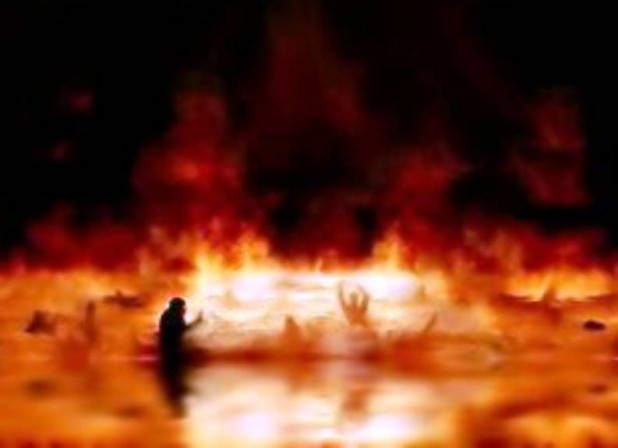
Many believe that after Jesus died on the cross, He descended into hell. The Apostle’s Creed certainly says this, but as for myself, I am undecided. Let’s look briefly at the evidence.
Acts 2:31
In Acts 2:31, Peter says that God did not leave the soul of Jesus in Hades, but raised Him up from the dead. The term “Hades” does not actually refer to hell as many believe, but is “the place of the dead.”
Sometimes, it refers to the underworld where the souls of men walk around like shadows. Frequently, “Hades” simply refers to the grave. It is not a mystical place, but is simply the hole in the ground where your body goes when you die. Most translators and Bible scholars believe that this is what Peter is referring to, and translate “Hades” as “the grave.”
Ephesians 4:8-10
This verse is often brought up as defense that Jesus descended into hell, but this is not the best understanding of this passage. In Ephesians 4:8, Paul talks about how Jesus ascended into heaven, and to explain this, Paul reminds His readers that Jesus was simply returning to where He came from, that is, heaven.
He only ascended from earth to heaven because He first descended from heaven to earth. The descent of Jesus was not from earth into hell, but was from heaven to earth.
1 Peter 4:6
Some believe that 1 Peter 4:6 indicates that Jesus descended into hell and preached the Gospel to those who are there.
If this is true, the question then is, “Why?” Was he giving them a second chance? Was He taunting them? Neither option makes much sense. Whatever this verse means, it must be understood in the context of other passages in the letter, such as 1 Peter 3:18-20. This text says that by the Spirit, Jesus preached to spirits who were in prison, who rebelled in the days of Noah.
While this could mean that Jesus descended into hell to preach to people in prison, why are the people who were alive in the days of Noah singled out? Some believe it was Noah who was doing the preaching by the Spirit, and he was preaching about Christ, but they did not believe, and so are now dead and in prison.
This passage is notoriously difficult, and is therefore a weak foundation upon which to build any doctrine about what Jesus did or did not do after His death and before His resurrection.
Miscellaneous Passages about Jesus’ Descent into Hell
Finally, some point to various other texts of Scripture such as the story of the rich man and Lazarus (Luke 16:19-31), and the report that at the resurrection of Jesus, many who were formerly dead were raised to life (Matt 27:52-53) as evidence that Jesus did go preach to some spirits in hell, or in a “suburb of hell” called Abraham’s Bosom, and some were raised back to life.
One of the verses used against the idea that Jesus descended into hell is Luke 23:42-43 where Jesus tells the thief on the cross that today, the thief would be with Jesus in paradise. If Jesus went to hell, how could He also be with the thief in paradise. Of course, some believe that the “paradise” to which Jesus refers was a “suburb” of hell called “Abraham’s bosom,” and this is the “hell” to which Jesus descended and preached, and from which He led captives in His train (Eph 4:8).
So did Jesus descend into hell? All of the evidence is fairly inconclusive.
So what do you think? Did Jesus descend into hell?
If so, why did He go there and how long was He there?
We will look at one more passage later which might possibly shed some further light on the subject.
Edit: 04/29/2011 – Here is a post I found which explains some of the background for this belief: Did Jesus Go to Hell?
The cross of Jesus is CENTRAL to everything!
Transform your life and theology by focusing on the crucifixion and resurrection of Jesus:
Fill out the form below to receive several emails from me about the death and resurrection of Jesus.
(Note: If you are a member of RedeemingGod.com, login and then revisit this page to update your membership.)




 Church tradition states that Jesus was crucified on a Friday. This is why we call it “Good Friday.”
Church tradition states that Jesus was crucified on a Friday. This is why we call it “Good Friday.” But if Jesus was crucified on Thursday, then the next day was not the Sabbath, right? Wrong. John 19:31 clearly tells us that this particular Sabbath was a High Day. In other words, it was not a weekly Saturday Sabbath, but was a special holiday Sabbath.
But if Jesus was crucified on Thursday, then the next day was not the Sabbath, right? Wrong. John 19:31 clearly tells us that this particular Sabbath was a High Day. In other words, it was not a weekly Saturday Sabbath, but was a special holiday Sabbath. 
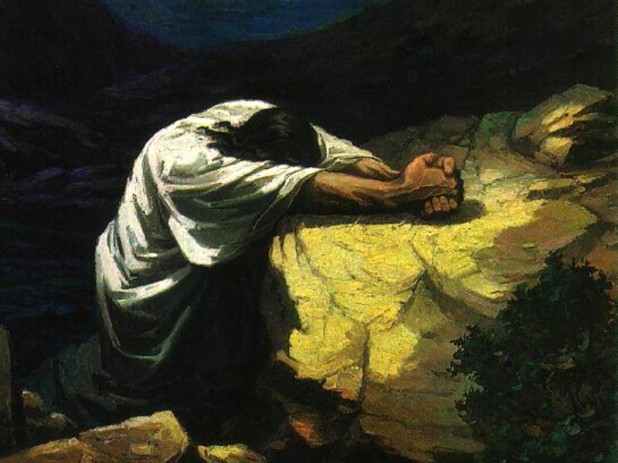
 Part of the problem is that we do not understand the Passover imagery which Jesus was using. Jesus and the apostles had just come from eating their Passover meal, during which time they would have drunk deeply from four cups of wine. At that time, the table would usually share one, large, communal cup. The custom was that when the cup came to the place you were reclining, you must drink from it as deeply as you could, before passing it on to the next person at the table.
Part of the problem is that we do not understand the Passover imagery which Jesus was using. Jesus and the apostles had just come from eating their Passover meal, during which time they would have drunk deeply from four cups of wine. At that time, the table would usually share one, large, communal cup. The custom was that when the cup came to the place you were reclining, you must drink from it as deeply as you could, before passing it on to the next person at the table.

 Though we can never know the spiritual agony that Jesus experienced on the cross, we see hints of it in what He says. For example, His fifth statement from the cross is “My God, My God, Why have you forsaken me?” Jesus, as the second person of the Trinity, has had constant fellowship with God the Father for all eternity. What must it have been like for Him now to have that relationship severed and broken? What must it have felt like for Jesus when our sin separated Him from God? Our sin broke the eternal fellowship of the Godhead!
Though we can never know the spiritual agony that Jesus experienced on the cross, we see hints of it in what He says. For example, His fifth statement from the cross is “My God, My God, Why have you forsaken me?” Jesus, as the second person of the Trinity, has had constant fellowship with God the Father for all eternity. What must it have been like for Him now to have that relationship severed and broken? What must it have felt like for Jesus when our sin separated Him from God? Our sin broke the eternal fellowship of the Godhead! Scholars widely disagree about what happened to Jesus after He died. Some believe He
Scholars widely disagree about what happened to Jesus after He died. Some believe He 

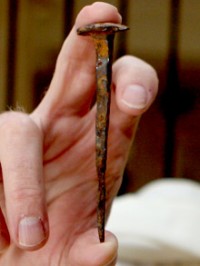 If the authorities wanted a quicker death, they would generally drive nails into the hands and feet of the victim. The nails were not driven into the palms of the hands as most pictures show. Rather, they were driven through the wrist near the hands. If the spikes were driven through the hands, the weight of the person would cause the nail to rip through the hands and the victim would fall off the cross. But when driven through the wrist, the set of bones which attach the wrist to the hand keep the hands from ripping free.
If the authorities wanted a quicker death, they would generally drive nails into the hands and feet of the victim. The nails were not driven into the palms of the hands as most pictures show. Rather, they were driven through the wrist near the hands. If the spikes were driven through the hands, the weight of the person would cause the nail to rip through the hands and the victim would fall off the cross. But when driven through the wrist, the set of bones which attach the wrist to the hand keep the hands from ripping free.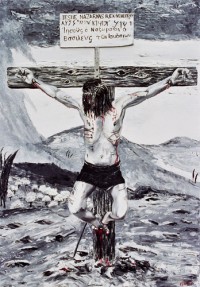 To take a breath, the victim would have to stand up on the nail through his feet, causing excruciating pain in the feet, but enabling him to take a breath. As long as he was putting all his weight on his feet, he could breathe. But when that became too painful, he would slump back down, putting all his weight on his wrists, and also returning to the condition of not being able to breathe.
To take a breath, the victim would have to stand up on the nail through his feet, causing excruciating pain in the feet, but enabling him to take a breath. As long as he was putting all his weight on his feet, he could breathe. But when that became too painful, he would slump back down, putting all his weight on his wrists, and also returning to the condition of not being able to breathe.
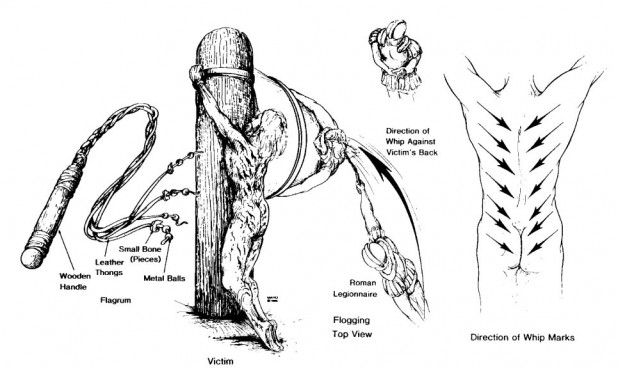
 The half-fainting Jesus is then untied and allowed to slump to the stone pavement, soaked with His own blood. The Roman soldiers see an opportunity to make a joke out of Him. Here is a provincial Jew claiming to be a king, but was now barely alive. So they throw a robe across His shoulders and place a stick in His hand for a scepter. To make the travesty complete, a small bundle of flexible branches covered with long thorns are woven into the shape of a crown and pressed into His scalp. Since head wounds always bleed a lot, the blood runs down His face and into His eyes.
The half-fainting Jesus is then untied and allowed to slump to the stone pavement, soaked with His own blood. The Roman soldiers see an opportunity to make a joke out of Him. Here is a provincial Jew claiming to be a king, but was now barely alive. So they throw a robe across His shoulders and place a stick in His hand for a scepter. To make the travesty complete, a small bundle of flexible branches covered with long thorns are woven into the shape of a crown and pressed into His scalp. Since head wounds always bleed a lot, the blood runs down His face and into His eyes.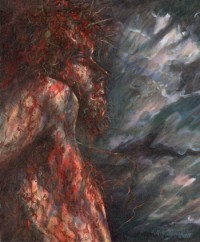 Most artists do not even come close in depicting what Jesus looked like after all of this torture. He was probably the most inhuman looking thing you’ve ever seen. The prophet Isaiah wrote of the Messiah: “They shall see the Servant of God beaten and bloodied, an object of horror; so disfigured many were astonished. His face and His whole appearance were marred more than any man’s, one would scarcely know it was a person…” (Isa 52:14).
Most artists do not even come close in depicting what Jesus looked like after all of this torture. He was probably the most inhuman looking thing you’ve ever seen. The prophet Isaiah wrote of the Messiah: “They shall see the Servant of God beaten and bloodied, an object of horror; so disfigured many were astonished. His face and His whole appearance were marred more than any man’s, one would scarcely know it was a person…” (Isa 52:14).
 His mission of atonement is nearly complete. Finally, He can allow His body to die. With one last surge of strength, He presses His torn feet against the nail, straightens His legs, looks into heaven, and utters His seventh and last cry, “Father, into your hands I commit my spirit.”
His mission of atonement is nearly complete. Finally, He can allow His body to die. With one last surge of strength, He presses His torn feet against the nail, straightens His legs, looks into heaven, and utters His seventh and last cry, “Father, into your hands I commit my spirit.”